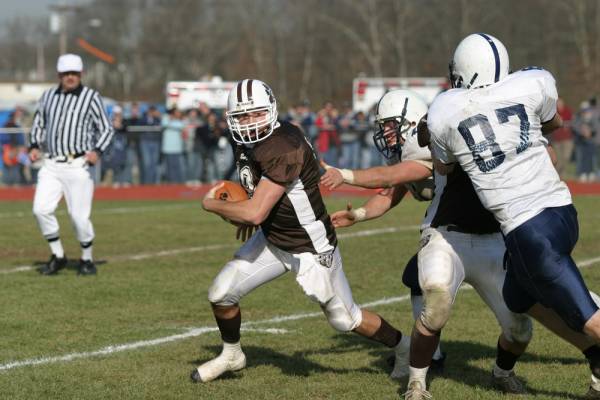In the previous installment in my series on the logical steps to determining the value of a physical training program, I addressed the basic fundamentals on what qualifies an activity as strength training, conditioning, or skill training.
In the previous installment in my series on the logical steps to determining the value of a physical training program, I addressed the basic fundamentals on what qualifies an activity as strength training, conditioning, or skill training.
Of the three, skill training continues to be misunderstood by the masses, and is thus in dire need of further discussion and clarification. Too many well-intended coaches and athletes have taken the wrong fork in the road and are involved in sub-par skill-enhancing measures.
I know the forthcoming discussion may cause some of you to suggest I am off-kilter, but I refuse to waver from the etched-in-stone but esoteric rationale supporting this issue.
Motor learning study, research, and practical application have been deemphasized or ignored by formal academia for some strange reason.
Is it due to blind ignorance or the marketing aspect of tools and programs that contradict what the research clearly avers? It’s time to face reality.
What Is Proper Skill Training?
What follows is a synopsis of proper skill training based on long-time proven principles. The research referenced goes back years, but that holds an irony.
Many commonly accepted facts we live by today were legitimized centuries ago and we accept them today with no resistance.
The laws of gravity, thermodynamics, chemical reactions, and physics are well accepted and not questioned. But when it comes to human motor learning principles and athletic skill development, we fall off the gray-area discussion cliff.
Moving forward, the forthcoming information pulled from the vault will validate the three requisites of proper skill training mentioned in part two of this series:
- Exact replication of the desired skill (no “almost” or “sort of” resemble the skill apply here).
- No abnormal external resistance should be included in a specific skill execution. This will alter the desired neural pathways of muscle activation and result in a different outcome.
- Perfect practice of skills repetitively will better the chances of replication during a sport competition. It’s second instinct as some call it.
A special thanks to Tim Wakeham, strength and conditioning Coach at Michigan State University, for many of the following links. I’m going to share with you the relevant research and conclusions, and what the practical application is to you.
Training Speed and Load
Brent Rushall and Frank Pyke, authors of Training for Sport and Fitness, concluded the principle of specificity means the maximum benefits of a training stimulus can only be obtained when it replicates the movement and energy systems involved in the circumstances of a specific sport.
Activities that look similar but are performed at slightly different speeds are most likely completely dissimilar in their training effects. Every alteration of movement path or apparatus used is a different neuromuscular pattern of movement development.
Even minor loads might produce negative training effects because of the subtle alterations to refined neuromuscular movement patterns. Extra-load resistances used on the extremities (even though minimal) have not been shown to be of value for training.
Much of the training effect from explosive power training is due to the motor learning of the skill associated with the activity. The actual requirements of the sport would seem to be the best training approach for the development of both speed and power.
Practice Often, But Rest a Lot
R. J. Shepard concluded a number of suggestions. Regarding single maximum contraction events, training is determined more by learning and practice characteristics than physical changes that occur within the muscle or body.
Such training is best achieved through maximally specific practice trials with adequate between-trials recovery. The volume of exact performance at competition intensity – that is, the specific skill learning – is the major training determinant for performance improvement in this type of activity.
For activities performed in under ten seconds, training at specific maximum intensities with sufficient recovery between trials is the major conditioning principle for these events.
For activities that take between ten to sixty seconds, the factors that surround skill learning and the repetition of correct trials should dominate the focus of training and will be the greatest contributors to performance improvements.

Sport Specific Training Should Be Sport Specific
Skill development is neurologically based and is specific to each and every minor variation of activity, especially for seasoned athletes. If an experienced athlete attempts to deliberately transfer some elements of one skill to another then the target activity will be adversely affected and made worse rather than better.
Training of skills must be specific. Repetition of the exact intensity required for competition performance is the only option one should be focused on once the quality and technical features of the specific skill have been maximized.
George Sage, author of An Introduction to Motor Behaviour: A Neuropsychological Approach, concluded the practice of non-specific coordination or quickness tasks will not produce transfer to specific sport skills.
In regards to quickening exercises that involve many rapid skillful movements, transfer of learning is highly specific and occurs only when practiced movements are identical.
Therefore, improve your speed and quickness with exact sport-specific activities. Avoid supposed “quickening” activities such as dot drills, fast feet drills, or anything performed against resistance.
Richard Schmidt, author of Motor Learning and Performance: From Principles to Practice concluded not to expect performance of one skill to positively affect the ability to perform well on a different skill, even when applying it to a broad category of other skills.
In example, some coaches use various balancing drills to increase general balancing ability or eye movement exercises to improve vision. These attempts to train fundamental abilities may seem fine, but they simply don’t work. Time, and often money, would be better spent practicing the eventual goal skill.
Suggested Reading on Sport Specific Training:
For more information, read this book Why Michael Couldn’t Hit (on NBA legend Michael Jordan’s attempt to play Major League Baseball), and review the following studies:
Robert Newton, Professor of Exercise and Sports Science at Edith Cowan University, discovered baseball throwing velocity was not improved following an eight-week medicine ball training program. What did improve baseball throwing was the use of time-proven strength training exercises done in the weight room coupled with exact-skill baseball pitching.
R. Harney, in Medicine and Science in Sports and Exercise, found a low correlation between the bench press, squat, and power clean performance and football blocking and charging power. Those exercises did not transfer well to those football skills.
T. Miller, in Medicine and Science in Sports and Exercise, investigated more football skills and concluded traditional strength and conditioning activities made them better at those specific traditional strength and conditioning activities.
There was minimal association between those activities and the dynamic performance of the vertical jump, twenty-yard shuttle run, and forty-yard dash.
There is little evidence of transfer of training effects to dynamic performances that are likely to be more associated with football playing performance.

Kathryn Refshauge, Chair of Physiotherapy and Dean of the Faculty of Health Sciences at the University of Sydney, concluded there was no transfer of balance and coordination from the wobble board to single-leg balancing. The skill of balancing on the unstable board did not reflect the skills required to balance on a stable surface.
The motor learning experts strongly suggest skill practice should be exact, precise, and replicate in-contest situations and circumstances. Thus, activities that are “almost” and “close” are probably ineffective.
Part four of this series analyzing effective training methods will address safety and those activities that are questionable. I hope you have not fallen prey to them.
In case you missed it:
- Training Activities for Athletes: The Logical Steps to Determine Their Value, Part 1
- Training Activities for Athletes: The Logical Steps to Determine Their Value, Part 2
- Training Activities for Athletes: Safety and Legitimacy, Part 4
- Training Activities for Athletes: The Final Steps to Determine Their Value, Part 5
References:
1. Harney, R. G., Purcell, M., Martinez-Arizala, G., Reed, E., & Serfass, R., “Relationship between anthropometric measurements, traditional modes of testing and training, and blocking performance in collegiate football linemen.” Medicine and Science in Sports and Exercise 33 (2001): 5.
2. Klawans, Harold L. M.D., “Why Michael Couldn’t Hit, and Other Tales of the Neurology of Sports.” (New York: W.H. Freeman & Co, 1996).
3. Miller, T. A., White, E. D., Kinley, K. A., Clark, M. J., & Congleton, J. J., “Changes in performance following long-term resistance training in division IA collegiate football players.” Medicine and Science in Sports and Exercise 31 (1991): 5.
4. Newton R. and McEvoy, K., “Baseball throwing velocity: a comparison of medicine ball training and weight training,” Journal of Strength and Conditioning Research 8 (3) (1994): 198-203.
5. Refshauge KM., Kilbreath SL., Raymond J., “Deficits in detection of inversion and eversion movements among subjects with recurrent ankle sprain.” Journal of Orthopaedic and Sports Physical Therapy 33 (2003): 166-176.
6. Rushall, B.S. and Pyke, F.S., “Training for Sport and Fitness.” (Melbourne, Australia: Macmillan of Australia, 1991).
7. Sage, G.W., “An Introduction to Motor Behavior: A Neuropsychological Approach.” (Philippines: Addison-Wesley, 1971).
8. Schmidt, Richard A., “Motor Learning and Performance: From Principles to Practice.” (Champaign, IL: Human Kinetics, 1991)
9. Shepard, R.J., “Aerobic vs. Anaerobic Training for Success in Various Athletic Events.” Canadian Journal of Applied Sport Sciences 3 (1978): 9-15.
Photos courtesy of Shutterstock.






